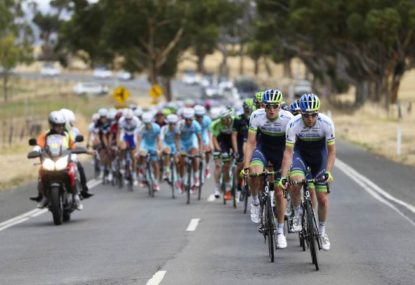'I've just won a stage of the Tour de France, mate!': Hindley grabs yellow jersey as Aussie blows Tour apart
Australia's Jai Hindley has said he is "lost for words" after a shock stage victory at the Tour de France earned him the leader's…

Anyone who follows cycling closely or has visited the Tour Down Under would agree that this is an exceptionally well-organised race.
Each race day, tens of thousands of fans line the roads to watch the riders fly past. A healthy percentage come from interstate, some even travel from overseas.
It’s a brilliant day out, picking your spot by the road and watching it all unfold in front of you.
For race director Mike Turtur, Tour Down Under week must be a relief as much anything, because in many respects the hardest time for him is when it comes to researching and mapping out the race route.
Like the Tour de France, Turtur’s planning won’t always be for the year ahead but for future years, as there are many logistics to nail down before a route can be locked away.
What makes his job increasingly difficult each year is the self-imposed limitations he operates under, such as having no more than two hours travel time from Adelaide, and ensuring the right balance of stages for sprinters, climbers and the all-rounders.
It’s important to keep the race fresh, by tweaking it as much as possible, while also trying to develop the traditions that matter when it comes to following an elite sport.
One of the increasingly occurring features of the Tour Down Under is the use of laps in the race route.
Of course, it’s not unique to the TDU. Many major one-day races, including World Championships, feature a loop of some kind. At the 2016 TDU, Stages 1, 2, 5 and 6 all revolve around laps.
Last year, the routes for Stages 1, 2, 3, 5 and 6 featured laps.
Fans couldn’t ask for more value for money, especially given it’s a free day out. I often wonder though, what do the riders think of lap racing?
Even if they’re doing 20-kilometre laps, you’re still eventually covering the same roads, corners, hills or whatever.
As discussed, it’s certainly a win for the spectators who get to see plenty of racing, and the TV broadcasters love it because they can set up cameras in one spot, instead of having resources stretched out along the route.
But does it make for better TV, and does it in any way take the edge off the racing? Do riders subconsciously save themselves for the final circuit, or know where to conserve energy because they know exactly what’s ahead?
Perhaps on a stage which just goes from A to B, as we’ll see today in Stage 3 from Glenelg to Campbelltown, there’ll be a subtle difference to the tempo and aggression.
Perhaps if, like today, there’s a decisive climb right at the end of the stage, the riders will save themselves anyway, laps or not?
No doubt the atmosphere spikes when riders pass spectators, whether it’s only once or as part of a lap race, and that can only give the riders a lift.
But if the peloton is just riding past, as opposed to racing past, are we seeing the best race we can see?
Turtur has often said that he can design whatever course he likes, but it’s the riders who decide what kind of race we get. They’ll either race hard or take it easy.
It must be a hard decision for race directors to make when designing a race route with so many factors to consider.
You can’t argue with the success of circuit racing at the Tour Down Under, with an estimated 110,000 watching Stage 2 yesterday. And year on year, the TDU delivers a week of fabulous entertainment.
Perhaps with the previously mentioned limitations, laps are the best way to go, or maybe one year we’ll see a TDU with fewer stages based on loops than we have in 2016.
It may not give us a better race, that may not really be possible, but it will give us a different race.
And with such logistical limitations, maybe that’s worth a try as well.